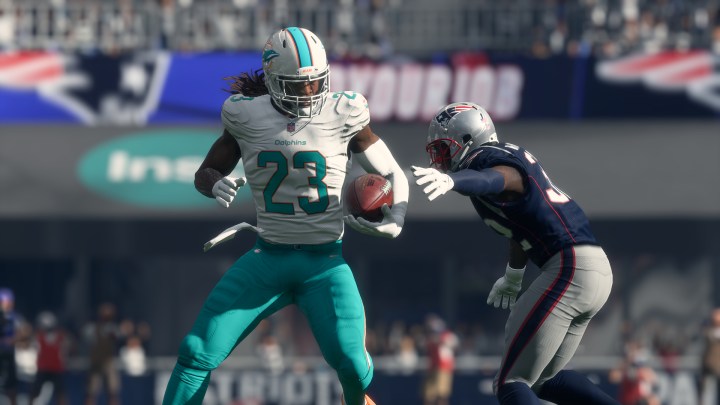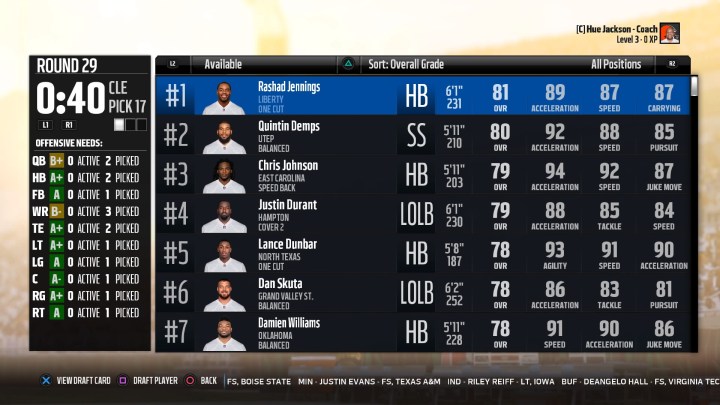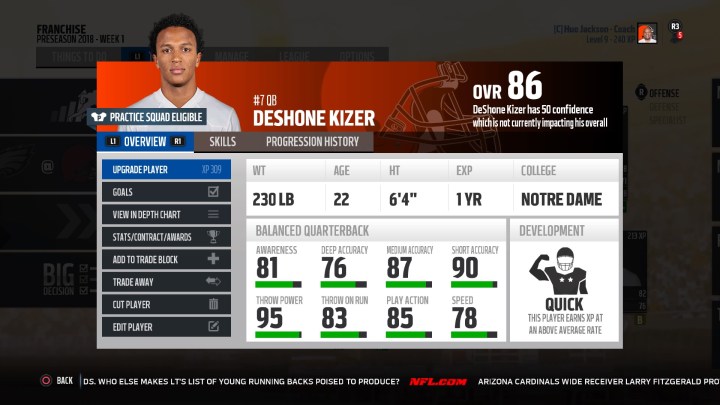
Traditional franchise

You have options for Madden NFL 18 franchise mode, but most players will likely spend the majority of their time in franchise mode within the traditional “Coach” role. You make all of the decisions an NFL head coach makes, and technically “play” as the coach, but when game time comes around, you play Madden as you’re accustomed to — controlling every facet of the in-game experience.
You can either take the helm of a current NFL team or draft a custom team from scratch. If you choose to go the latter route, check out the tips below, otherwise skip to the bottom section for general franchise mode tips.
How to draft a quality team
To build a custom team, simply open a new franchise in the cloud and choose a team. Then, in the “Starting Point” setting, choose Fantasy Draft.
In real life, the NFL Draft has seven rounds. In Madden NFL 18, since you’re filling out an entire active roster, be prepared for a 53-round draft. For the first few rounds, you’ll have a minute and a half to pick a player, but as the rounds pass, your time to make a pick will drop down to 45 seconds.
To build a successful Madden roster, you need to be smart in the draft. So how should you allocate your picks?
For the first few rounds at least, there’s a general formula. With your first round pick, we recommend drafting the highest rated QB available. You have no control over the draft order so your pick could come at the beginning, midway, or at the end of each round. In the second round, go for either an offensive linemen or a defensive linemen. Whichever one of those you don’t select in the second round, you should pick up in the third round. In the fourth round, you should still be able to snag an elite running back. In the fifth, shoot for a cornerback or an elite wide receiver. Whichever you don’t take in the fifth, pick that position up in the sixth.
After the sixth round, we recommend switching back to the offensive and defensive lines for your next two picks. Then, pick up a secondary receiver or a safety, and pick up whichever you didn’t pick in the following round.
Ten rounds in, you should have a solid core. As you draft, you’ll see that each position will have a grade next to it to let you know how you’re doing. From this point on, we recommend filling the remaining positions with the best available players. Thankfully, it’s broken down by both overall player rating and by position to make it easier on you.
As for how many players you should have at each position, follow these rough guidelines, but you can tweak it to taste and player availability. There’s no single, optimal composition. You can check out all current NFL rosters to see variations of the breakdown.
- QB: 2
- Wide Receiver: 6
- Running back: 4
- Tight End: 3
- Offensive linemen (Centers, Guards, Tackles): 9
- Defensive linemen (Tackles, Ends): 9
- Linebacker: 8
- Defensive backs (Cornerbacks, Safeties): 10
- Kicker: 1
- Punter: 1
General franchise tips

Weekly training: Each week before a game, you have the opportunity to train the offense and defense with skills exercises. The game automatically selects a skills training that is beneficial for the upcoming opponent, but you still have choices to make. You can select three focus players who will gain the most experience from the exercise. Generally, up and coming players like rookies or burgeoning stars should be your focus players. You have the option to simulate the training and still receive experience points, but you will receive the greatest reward by actually playing the exercises and achieving a Silver or Gold rank.

Upgrade attributes: After each game, a list of players with available attribute upgrades displays on screen. The game recommends attributes to upgrade, but sometimes you may want to go rogue and choose a different option. Usually we opt for upgrading the player’s lowest attribute value.

Pay attention to goals: To spice things up, players have individual weekly goals which, when reached, dole out bonus experience points. To check your weekly goals, simply click on any player in the team menu and scroll over to “Weekly Goals.” Players also have season and milestone goals, which you can build on throughout the course of the season.

Upgrade roster: In the main franchise mode menu, you can click on “Improve Team” to look at available free agents. This menu will also tell you where your team is weakest positionally. If you don’t see an available free agent you like, you can head over to the Trade Center. From here, you can check out players that are on the trading block — meaning that teams are eager to send them away — or propose a manual trade. Once again, you should pay special attention to your top five position needs on the sidebar. On the flip side, you can also send one of your players to the trading block by navigating to “My Team,” clicking the player, and selecting “Add to Trade Block.” That way you can field offers from opposing teams rather than seeking them out yourself.
Negotiating contracts: As the season wanes, you will gradually be notified that players with expiring deals are up for contract negotiations. If the player is a starter, and an integral part of the team, make the fair offer as noted on the screen (typically you’ll go through a few weeks of negotiations with a player to get the contract/bonus to their liking regardless). But if the player isn’t an important part of your roster and barely ever plays, we recommend waiting until the off-season. You don’t want to tie up future cap space when you don’t know the caliber of players who will be made available at the end of the year.
Scout players: Throughout each season, you’ll earn scouting points which can be used to unlock grades for players in the upcoming draft class. Make sure to use these as you get them, since they degrade by half if unused from one week to the next. After you “scout” the player, they will receive a draft grade identifying which round they are likely to go in. You can then go ahead and add players that look promising to your draft board.
Post-season draft: After each season, you have four weeks to prepare for the draft. In that time, you will receive more scouting points for filling out your draft board. When the draft rolls around, it will be a traditional seven-round affair. If your draft board is set, you can tell the computer to automatically draft your best available prospect, or you can manually pick players as the draft plays out. Always pay attention to team needs. And if your team is already pretty great, think about trading some of your picks for future drafts. You have the option to sift through trade offers before picking. We were able to flip an early second round pick for an early first round pick in next year’s draft.
Play the Moments: Franchise mode is time consuming but you can make it easier on yourself with Madden NFL 18‘s play style settings. You can either play the whole game (roughly 45 minutes), play only offensive possessions or only defensive possessions, or, our personal favorite — “Play the Moments.” In this setting, you play both offensive and defensive possessions, but only crucial plays — the red zone, third downs, last two minutes of each half. Play the Moments works well, and even though you don’t play the whole game, you still feel in control of your destiny most of the time.
The dedicated player approach

Maybe you just want to control your favorite superstar or create a soon-to-be superstar of your own. You can do this by changing your role from the coach to a player when setting up franchise mode.
If you create your player, you have the option to choose from any defensive player or any ball-dominant offensive position (sorry, no kickers or punters). While you can modify everything down to the type of armbands your created player wears, you have to pick between different pre-made skill sets. For example, you can pick a balanced QB or a mobile QB, or a balanced WR or a speedy wide receiver. At the start, you can’t modify their attributes. Interestingly, you can choose whether your created player was an early pick, a late pick, or went undrafted. Choosing one of the latter two options means your player will have lighter expectations put upon him.
At the start of the season, regardless of whether you created a player or are playing as Tom Brady, you have to set a season goal. If you’re confident in your abilities, up it from the default, but if you’re unsure whether you will reach it, stick with the baseline goal which corresponds to your player’s position.
After setting your goal, there’s not much to it besides going out on the field and performing to the best of your ability. Even though you only control one player after the snap, you still get to pick the plays for your side.
We’ve found that if you want to go the dedicated player route, choosing to play as a running back or wide receiver is the most rewarding on offense. Playing as the QB is far too similar to the actual franchise mode, but without the control of team decisions.
On the defensive side of the ball, playing as either a linebacker or cornerback tends to get you involved in the most exciting plays.
Like traditional franchise mode, weekly trainings are available. These are far more important here because your job is only to make your player the best he can be. As you progress, you’ll gain experience points that can be used to upgrade your player’s stats.
Ownership

To be honest, we don’t think owner mode adds much to the franchise experience at all. By and large, it mirrors the traditional “coach” role as described in detail above. The only real difference is that along with team decisions and on-the-field performance, you get to manage the team’s more tedious finances. If the idea of tinkering with ticket prices, concession stand prices, and renovating stadium bathrooms sounds appealing, this is the mode for you.
Change your role to the owner when setting up your franchise. In the “Manage” section you’ll see a menu for “My Owner.” From here you can do things like check out finances and revenue, make stadium renovations, see how jersey sales are doing, and make changes to your coaching staff.
Here’s the thing about all of these financial decisions: If you play well on the field, fans will fill the seats, jerseys will sell, and your team’s revenue will inevitably go up. So if you choose to be an owner, don’t fret about the small things. Worry about winning. The meta-game financial info isn’t very robust, and any financial woes and fan disappointment that say, the Cleveland Browns have, can be cured by winning games. We turned Cleveland Browns fans from the least happy bunch of football fans to one of the happiest in a single year (with a Super Bowl win). Wins are what matters here. The rest will resolve itself over time.
But if not, you can always move the team if your owner ratings completely plummet. We weren’t able to get our rating low enough to allow us to move the team. And to be honest, we wouldn’t move the Browns … again.
Madden NFL 18
We hope our Madden NFL 18 franchise guide was useful. Make sure to check out our offense guide, defense guide, and kick blocking guide for more tips and tricks. Will cover star Tom Brady avoid the Madden curse? Our history of the Madden curse details the ominous odds he faces.


